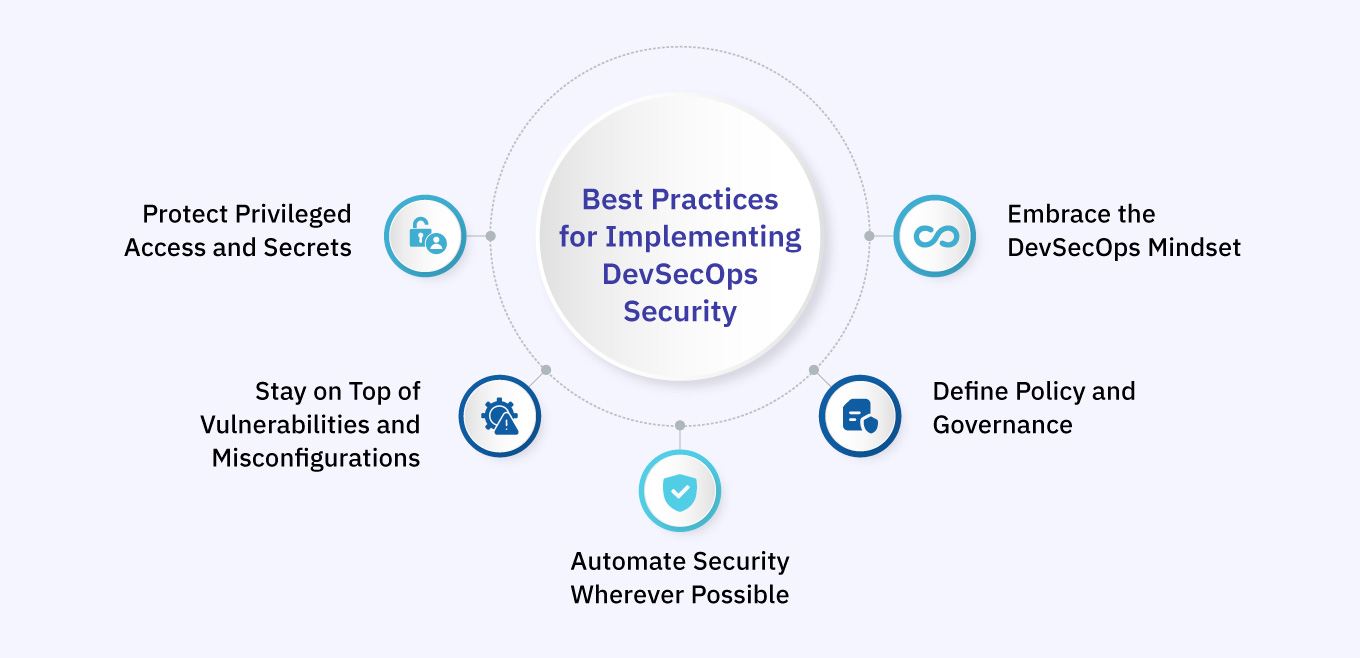Do you think your data is secure?
Every organization faces a constant barrage of cyber threats, which cost businesses an average of 15% of their annual revenue and contribute to a projected total loss of $10.5 trillion by this year.
Traditional security approaches are reactive, addressing vulnerabilities only after they have been exploited. This introduces significant risk across the software development lifecycle. Organizations can establish a proactive security approach by integrating DevSecOps practices with real-time threat intelligence and automated security testing. This approach embeds security into every development phase, enabling continuous risk mitigation and faster incident response.
DevSecOps: Where Speed Meets Security
DevOps helped speed up software delivery, but often at the cost of security. Traditional approaches add security at the end, leading to missed vulnerabilities, rework, or even costly breaches.
DevSecOps changes the game. It integrates security into the design, code, and every stage of the SDLC. By “shifting left,” teams catch risks early when they are easier and cheaper to fix.
With automated code scanning, secure CI/CD pipelines, and real-time threat monitoring, DevSecOps makes security continuous, not optional. It also simplifies compliance and creates a transparent, auditable development process.
With cyber threats escalating, security needs to be implemented from day one and not rushed under pressure. DevSecOps helps businesses embed security without compromising speed or agility.
By blending speed with security, DevSecOps transforms how teams build and deliver software. Here’s how it adds value.
What are the Benefits of DevSecOps?
- Faster, safer delivery: Fix issues early and reduce costly rework.
- Proactive protection: Spot and resolve threats before they grow.
- Rapid patching: Minimize vulnerability windows.
- Built-in automation: Security embedded into your CI/CD pipeline.
- Scalable and repeatable: Adapts to your growth and tech landscape.
The Role of DevSecOps in Optimizing Business Security

How does DevSecOps improve security? It transforms security from a reactive checkpoint to a proactive, automated process embedded throughout the development cycle.
Without DevSecOps, security is often overlooked in the race to deploy. Teams rush to meet deadlines, and vulnerabilities slip through, leading to rework, risks, or breaches. DevSecOps flips this script by making security a built-in part of development and operations from the very beginning.
Here is how it drives stronger security outcomes:
Proactive by Design
DevSecOps integrates security into every phase of the SDLC, not just at the end. By identifying vulnerabilities early in design, development, or testing, teams can fix issues before they escalate into serious problems. It is a shift from reactive fixes to proactive prevention.
Automation-Powered Security
With CI/CD pipelines, automated testing and code scans are no longer manual checkpoints. Security runs in sync with development, ensuring every build is reviewed, tested, and secured without slowing delivery.
Faster Response to Threats
Built-in monitoring tools like Prometheus, Grafana, ELK Stack (Elasticsearch, Logstash, Kibana), and AWS CloudWatch provide real-time insights into your systems. These tools help teams detect unusual patterns, performance issues, or potential security incidents as they happen.
By setting up automated alerts and dashboards, teams can take immediate action to reduce the impact of attacks and ensure systems remain stable and secure.
Secure CI/CD Pipelines
Every deployment in a DevSecOps workflow undergoes automated validation. This continuous integration ensures faster software release without compromising integrity or security.
Continuous Compliance and Visibility
Compliance is no longer an audit-time scramble. DevSecOps makes every step traceable with tools that scan for anomalies, enforce policies, and ensure your software meets industry regulations.
Culture of Collaboration
Security becomes everyone’s responsibility. Dev, Sec, and Ops teams work together from day one, breaking silos and sharing ownership of security goals.
Built to Scale
As your business grows, so do your security needs. DevSecOps frameworks are scalable and flexible, helping your team adapt without disrupting development or compromising protection.
Now that we’ve covered how DevSecOps is critical in strengthening business security, let’s discuss how to get it right. Simply adopting DevSecOps isn’t enough—how you implement it makes all the difference.
Best Practices for Implementing DevSecOps Security


Integrating security into your development process should not slow you down; it should make you stronger, faster, and more resilient. When done right, DevSecOps empowers software development teams to innovate with confidence. Here are some best practices that will help you embed security seamlessly into your pipeline:
Embrace the DevSecOps Mindset
Security isn’t a checkbox, but it is a shared responsibility. To truly adopt DevSecOps, developers need to implement security into every development lifecycle stage. That means:
- Kickstarting projects with security in mind, not as an afterthought
- Bringing Dev, Sec, and Ops teams together from the beginning
- Using automation to embed security checks across the pipeline
- Monitoring systems continuously for threats
- Establishing clear, up-to-date security policies
- Staying current with evolving risks and vulnerabilities
More than anything, it is about building a culture where security is a top priority and not a last-minute hustle.
Define Policy and Governance
You cannot manage what you don’t define. Having clear security policies and governance frameworks ensures your teams are not guessing they are aligned, proactive, and consistent. With the right guardrails in place:
- Everyone knows their role and responsibilities
- Mistakes and missteps are minimized
- Teams can respond faster to incidents
- Compliance becomes simpler and more reliable
- You are better prepared for audits, regulations, and evolving threats
Automate Security Wherever Possible
Manual checks can not keep up with the pace of modern development. Automation is a necessity. With the right automation tools in place, you can:
- Run vulnerability scans automatically with every build
- Continuously monitor code, infrastructure (especially through Infrastructure as Code), and deployments
- Use IaC tools like Terraform, Pulumi, or AWS CloudFormation to define secure infrastructure and catch misconfigurations early
- Get real-time alerts for potential threats
- Auto-patch known vulnerabilities
- Generate logs and flag anomalies before they turn into issues
- Stay updated on emerging risks through automated threat feeds
The result? Faster releases, fewer blind spots, and stronger defenses.
Stay on Top of Vulnerabilities and Misconfigurations
Hackers don’t break in; they log in through open doors. Regular scanning for vulnerabilities and configurations ensures you are not leaving an easy way in.
- Conduct frequent scans to find and fix security gaps early
- Disable unused services and enforce access controls
- Keep systems and software updated
- Follow configuration best practices tailored to your tech stack
It is all about minimizing risk without slowing down momentum.
Protect Privileged Access and Secrets
Sensitive credentials like API keys, tokens, and passwords are gold to attackers. Mishandling them can cause massive damage. That is why managing privileged access and secrets is non-negotiable:
- Limit access based on roles—no one should have more access than they need
- Rotate credentials regularly and store them securely (not in plain text!)
- Use secret management tools to prevent accidental exposure
- Monitor for unusual access patterns
One weak link in access control can undo everything else. Get this right, and your security posture strengthens significantly.
By building these best practices into your DevSecOps strategy, you add security and transform it into a continuous effort that scales with your business.
How People10 Helps with DevSecOps Implementation
Looking to make security an integral part of your DevOps culture? That’s where People10 steps in.
We combine our deep expertise in security testing across web apps, mobile apps, APIs, and enterprise software. With the power of DevSecOps accelerators, we help you build secure systems fast, smart, and at scale.
Here is how we support your DevSecOps journey:
- Built by DevOps and Security Experts: Our teams understand that DevSecOps isn’t just about tools; it’s a cultural shift. We align your operations, development, and security teams to create a seamless, agile, and security-first mindset across your entire delivery pipeline.
- Accelerators That Speed Up Security Integration: Our experts developed frameworks that allow digital businesses to embed security into the CI/CD pipeline without slowing down innovation.
- Security Automation from Day One: With People10-DevSecOps, you can automate DAST (Dynamic Application Security Testing) to identify runtime vulnerabilities before code goes live. This means continuous testing, early threat detection, and reduced risk exposure.
- Secure Code Delivery, Every Time: We optimize security across your SDLC and CI/CD workflows, ensuring secure code is deployed confidently, not as an afterthought.
66% of Teams Reduced Security Incidents with DevSecOps. Ready to Join Them?
Partner with People10 to embed security into your pipeline.
Author
Shrutha Sekharaiah brings over 13 years of experience in delivering innovative, scalable solutions. His broad expertise in technology and focus on collaboration and mentorship drive the creation of robust systems enhancing efficiency and performance.




